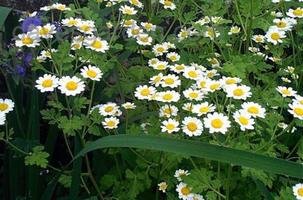





Tanacetum parthenium. This pretty, versatile herb is a favourite in my garden. Hopefully, by the end of this article, it will be one of yours too.
(Editor's Note: This article was originally published on March 1, 2008. Your comments are welcome, but please be aware that authors of previously published articles may not be able to promptly respond to new questions or comments.)
Feverfew has been written about for its medicinal uses since 1597. It has been a staple in English gardens for centuries. Widely known for its relief of headache and vertigo, this plant is also used to help prevent blood clots, as an anti-inflamatory for the relief of arthritis, for the relief of some types of menstrual problems and as a digestive aid. Always consult a physician before taking any herbal remedy.
Feverfew is a perennial herb native to southeast Asia and Europe. In more recent times it has become naturalized in North and South America and Australia. Plant feverfew among aphid loving perennials and annuals since it is known to repel these unwanted insects. It is said to have insecticidal properties and a solution of feverfew dabbed on the skin will repel biting insects. The crushed leaves are also known to deter moths.
Why Feverfew? This versatile plant grows from between 9 inches and 2 feet, making it a good border plant and it does extremely well in containers. Last year I let it grow in some half whiskey barrels, popped in a few extra blanket flowers I had, and the result was beautiful. It will grow in full sun or full shade and in the poorest of soils. I have even had it grow up between the cracks of asphalt paving. It makes a wonderful, bright filler between annuals and perennials. It can even be grown on rocky slopes and walls!
Feverfew self seeds readily, yet has a weak root system and pulls easily, making it easy to control. In some areas it is considered a noxious weed. Yet, I like it as a good filler in borders and along paths.  After blooming, the flowers turn brown, but if you cut the plant back by half it will bloom again, giving flowers until frost. I never tire of its pretty little flowers. They resemble a cross between a chrysanthemum and a daisy. Feverfew survives my zone 5a winters. In the spring, when the snow has melted, the plants are still there, semi-green. I just trim back the previous years growth to roughly 3 inches.
After blooming, the flowers turn brown, but if you cut the plant back by half it will bloom again, giving flowers until frost. I never tire of its pretty little flowers. They resemble a cross between a chrysanthemum and a daisy. Feverfew survives my zone 5a winters. In the spring, when the snow has melted, the plants are still there, semi-green. I just trim back the previous years growth to roughly 3 inches.
Propagation is simple. Stem cuttings can be stuck in the ground, or in pots, in the spring and early summer. Since it self seeds so easily, there is always an abundance of young plants to be moved. They transplant easily. Mature plants can be divided as well, although, if done on a sunny day they may wilt, they bounce back readily. Seeds can be winter sown, or started early in a greenhouse or on a windowsill..
This is one of my most requested perennials. Almost everyone that stops to look at my gardens wants a few of these plants. They do not require any special attention making them perfect in any garden. Drought-tolerant, they would be a nice addition to any garden in an area where watering restrictions occur. They come in single or double varieties, both equally beautiful.
occur. They come in single or double varieties, both equally beautiful.
Consider ffeverfew the next time you are shopping for a new perennial. These attractive, versatile, easy to grow plants are often overlooked. They are one of my favourites, maybe they will become one of yours as well.
Photo credits go to, bemidjigreen and poppysue. The last one is mine....
Copyright © www.100flowers.win Botanic Garden All Rights Reserved